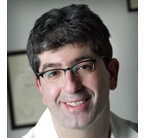
George Jallo, M.D.
When 13-year-old Dillon Simmons hit the ice at the final buzzer of his last hockey game of the season and couldn’t get up, little did he know how much his world would change. His parents suspected a concussion and drove Dillon to the Emergency Department at HealthPark Medical Center near their home in Ft. Myers, FL. Dillon passed the concussion screen, but his mom, Denise Simmons, asked if he could undergo imaging, noting that Dillon had lately been leaning to one side while walking.
“Something felt just not right,” she says. Indeed, an hour later the family was looking at an image of a golf-ball-size tumor in Dillon’s brain.
“It was quite apparent, right in the middle of his brain stem,” says Simmons.
HealthPark called All Children’s Hospital in St. Petersburg, Fla., which arranged to have Dillon air-lifted for an immediate evaluation. There, following more imaging and a biopsy, pediatric neurosurgeons diagnosed the brain stem tumor as a low grade polycystic astrocytoma, and recommended surgery with Johns Hopkins Children's Center pediatric neurosurgeon George Jallo.
Simmons recalls, “The neurosurgeon said, ‘I don’t want you to worry about this but it’s out of my league. If anyone can get this tumor out, it’s Dr. Jallo.’”
After the images were sent to Jallo in Baltimore, Simmons called him: “He said, ‘I’m absolutely confident I can do this. I’ve done a lot of these and if it was my son, I’d want me doing it.’” Simmons adds, “Then I could breathe a little bit.”
Dillon had only one question – would he be able to play hockey again. Jallo said “yes.”
But getting Dillon back on the ice would be no easy task, as operating on the brainstem has a slim margin for error. Jallo gains access to the brainstem through the back of the head and – after gently lifting the cerebellum – the floor of the fourth ventricle of the brain, a compact cavity rich with cranial nerves responsible for multiple functions. Nick a nerve and the patient may lose the function to hear, smile or swallow. But by using intraoperative neurophysiological monitoring of these nerves, as well as an MRI map of the motor pathways, Jallo is able to find a safe corridor to the brainstem tumor. Once there he begins his innovative approach – tediously resecting the tumor from the inside out.
“By working within the tumor, and avoiding the area between the tumor and the brainstem where people have problems, we’re able to safely remove a large portion of it,” says Jallo. “If monitoring shows any activity or firing of the nerves, you know you’re getting close, so you have to limit your resection of the tumor.”
In Dillon’s case, Jallo was able to remove 65 percent of the tumor; the residual tumor will be reduced in size by follow-up chemotherapy and radiation therapy. His only new deficit, Jallo says, is numbness in his left hand, which is improving. To what does Jallo attribute Hopkins’ success in such cases?
“The experience of seeing so many of these brainstem tumors and our multidisciplinary approach,” says Jallo. “Before we delve into surgery we discuss every case at neuro-oncology conference and come up with a consensus opinion.”
For more information, call 410-955-7851.
